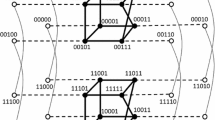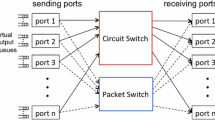Abstract
Physical topologies are evolving from elementary survivable rings into complex mesh networks. Nevertheless, no topology model is known to provide an economic, systematic, and flexible interconnection paradigm for ensuring that those meshes bear resilience features. This paper argues that intrinsic resilience can be brought by twin graph topologies, as they satisfy equal length disjoint path property with minimal number of physical links. Also, they benefit from property preserving recursive methods to graciously scale up/down and merge/split topologies. An exhaustive investigation is performed across twin graph families composing networks from 4 to 17 nodes, whereas diverse real-world topologies and ring networks are used as benchmarks. First, we illustrate the growing and the merging processes, and discuss the topology diversity of twin graphs. We analyze the impact of single cable cuts between neighbouring nodes, then we stress topologies with 2, 3, and 4 simultaneous cable cuts. Improved resiliency is seen for neighbor nodes and also reduction of cut sets able to disconnect the twin topologies in comparison with real-world networks. At transport layer, we derive and validate an upper bound for additional capacity required to implement \(1+1\) path dedicated protection. As networks grow larger, this protection cost is consistently reduced compared to benchmark topologies. We also test the suitability of our approach at optical layer regarding transponders consumption. Finally, we present as a use case the redesign of CESNET into a resilient network.







Similar content being viewed by others
References
Al-Kuwaiti, M.H., Kyriakopoulos, N., Hussein, S.: Towards a standardized terminology for network performance. IEEE Trans. Reliab. 57(2), 267–271 (2008). https://doi.org/10.1109/TR.2008.920800
Alexander, S.: Intelligent infrastructure provides new broadband opportunities, slides from Ciena CTO Steve Alexander’s presentation at the CommDay Melbourne Congress event, October 11-12, 2011 in Melbourne, Australia. Available at: http://www.slideshare.net/CienaCorp/intelligent-infrastructure-provides-new-broadband-opportunities
Baroni, S., Bayvel, P.: Wavelength requirements in arbitrarily connected wavelength-routed optical networks. J. Lightw. Technol. 15(2), 242–251 (1997)
Chang, J.M., Ho, C.W.: The recognition of geodetically connected graphs. Inf. Process. Lett. 65(2), 81–88 (1998). https://doi.org/10.1016/S0020-0190(97)00201-9
Chang JM, Ho CW, Hsu CC, Wang YL (1996) The characterizations of hinge-free networks
Farley, A.M., Proskurowski, A.: Minimum self-repairing graphs. Gr. Comb. 13(4), 345–351 (1997). https://doi.org/10.1007/BF03353012
Fortz B, Labbé M (2002) A tabu search heuristic for the design of two-connected networks with bounded rings. Tech. Rep. IAG Working Papers 74-02, Université Catholique de Louvain, Ottignies-Louvain-la-Neuve
Fortz, B., Labbé, M.: Two-connected networks with rings of bounded cardinality. Comput. Optim. Appl. 27(2), 123–148 (2004). https://doi.org/10.1023/B:COAP.0000008649.61438.6b
Foxwell, E.B., Ombuki-Berman, B.: Particle swarm optimisation for the design of two-connected networks with bounded rings. Int. J. High Perform. Syst. Archit. 1(4), 220–230 (2008). https://doi.org/10.1504/IJHPSA.2008.024206
Frascolla, V., Dominicini, C.K., Paiva, M.H.M., Caporossi, G., Marotta, M.A., Ribeiro, M.R.N., Segatto, M.E.V., Martinello, M., Monteiro, M.E., Both, C.B.: Optimizing C-RAN backhaul topologies: A resilience-oriented approach using graph invariants. Appl. Sci. 9(1), 136 (2019). https://doi.org/10.3390/app9010136
Grey M, Theil M, Rossberg M, Schaefer, G (2015) Towards a model for global-scale backbone networks. In: 2015 IEEE International Conference on Communications (ICC). pp. 6086–6091 . https://doi.org/10.1109/ICC.2015.7249292
Habib, M.F., Tornatore, M., Dikbiyik, F., Mukherjee, B.: Disaster survivability in optical communication networks. Comput. Commun. 36(6), 630–644 (2013). https://doi.org/10.1016/j.comcom.2013.01.004
Harary, F.: Graph theory. Addison-Wesley Publishing Company, Philippines (1969)
ITU 2015: Ethernet ring protection switching. Tech. Rep. Recommendation ITU-T G.8032/Y.1344, International Telecommunication Union (Aug 2015)
Kamiyama N, Satoh D (2008) Network topology design using analytic hierarchy process. In: 2008 IEEE International Conference on Communications. pp. 2048–2054 . https://doi.org/10.1109/ICC.2008.393
Kerivin, H., Mahjoub, A.R.: Design of survivable networks: A survey. Networks 46(1), 1–21 (2005). https://doi.org/10.1002/net.v46:1
Labourdette, J.F., Bouillet, E., Ramamurthy, R., Akyama, A.A.: Fast approximate dimensioning and performance analysis of mesh optical networks. IEEE/ACM J. Trans. Netw. 3(4), 906–917 (2005)
Liberato, A., Martinello, M., Gomes, R.L., Beldachi, A.F., Salas, E., Villaca, R., Ribeiro, M.R.N., Kondepu, K., Kanellos, G., Nejabati, R., Gorodnik, A., Simeonidou, D.: RDNA: Residue-defined networking architecture enabling ultra-reliable low-latency datacenters. IEEE Trans. Netw. Serv. Manag. 15(4), 1473–1487 (2018). https://doi.org/10.1109/TNSM.2018.2876845
Miladić-Tešić, S., Marković, G., Radojičić, V.: Traffic grooming technique for elastic optical networks: A survey. Optik 176, 464–475 (2019). https://doi.org/10.1016/j.ijleo.2018.09.068
Morais RM, Pavan C, da Rocha JRF, Pinto AN (2011) Estimating extra capacity for dedicated protection in mesh optical transport networks. In: 16th European Conference on Networks and Optical Communications and Conference on Optical Cabling and Infrastructure (NOC/OC). pp. 165–168. IEEE
Narula-Tam, A., Modiano, E., Brzezinski, A.: Physical topology design for survivable routing of logical rings in WDM-based networks. IEEE J. Sel. Areas Commun. 22(8), 1525–1538 (2004). https://doi.org/10.1109/JSAC.2004.830463
Papanikolaou, P., Christodoulopoulos, K., Varvarigos, E.: Joint multi-layer survivability techniques for IP-over-elastic-optical-networks. IEEE/OSA J. Opt. Commun. Netw. 9(1), A85–A98 (2017). https://doi.org/10.1364/JOCN.9.000A85
Pavan, C., de Lima, L.S., Paiva, M.H.M., Segatto, M.E.V.: How reliable are the real-world optical transport networks? IEEE/OSA J. Opt. Commun. Netw. 7(6), 578–585 (2015). https://doi.org/10.1364/JOCN.7.000578
Pavan, C., Morais, R.M., da Rocha, J.R.F., Pinto, A.N.: Generating realistic optical transport network topologies. IEEE/OSA J. Opt. Commun. Netw. 2(1), 80–90 (2010). https://doi.org/10.1364/JOCN.2.000080
Plesnik, J.: On the sum of all distances in a graph or digraph. J. Gr. Theory 8(1), 1–21 (1984). https://doi.org/10.1002/jgt.3190080102
Plesnik, J.: Towards minimum k-geodetically connected graphs. Networks 41(2), 73–82 (2003). https://doi.org/10.1002/net.10060
Ramirez, W., Masip-Bruin, X., Marin-Tordera, E., Sanchez-Lopez, S.: Managing resilience in carrier grade networks: Survey, open issues and trends. Comput. Commun. 61, 1–16 (2015). https://doi.org/10.1016/j.comcom.2015.02.015
Resendo, L.C., Ribeiro, M.R.N., Pires, J.J.O.: Optimal multilayer grooming-oriented design for inter-ring traffic protection in DNI multiring WDM networks. J. Opt. Netw. 7(6), 533–549 (2008). https://doi.org/10.1364/JON.7.000533
Tessinari RS, Paiva MHM, Monteiro ME, Segatto MEV, Garcia AS, Kanellos GT, Nejabati R, Simeonidou D (2018) On the impact of the physical topology on the optical network performance. In: 2018 IEEE British and Irish Conference on Optics and Photonics (BICOP). pp. 1–4 . https://doi.org/10.1109/BICOP.2018.8658361
Vassoler, G.L., Paiva, M.H.M., Ribeiro, M.R.N., Segatto, M.E.V.: Twin datacenter interconnection topology. IEEE Micro 34(5), 8–17 (2014). https://doi.org/10.1109/MM.2014.63
Ventresca, M., Ombuki, B.M.: A genetic algorithm for the design of minimum-cost two-connected networks with bounded rings. Int. J. Comput. Intell. Appl. 05(02), 267–281 (2005). https://doi.org/10.1142/S1469026805001611
Wu, T.H.: Fiber Network Service Survivability. Artech House Inc, Norwood (1992)
Acknowledgements
This work was partially supported by FAPES, CAPES, and CNPq (Brazil), and NSERC (Canada). It is also part of the FUTEBOL project, which has received funding from the European Union’s Horizon 2020 (Grant No. 688941), as well from the Brazilian Ministry of Science, Technology and Innovation (MCTI) through RNP and CTIC.
Author information
Authors and Affiliations
Corresponding author
Additional information
Publisher's Note
Springer Nature remains neutral with regard to jurisdictional claims in published maps and institutional affiliations.
This work was partially supported by FAPES, CAPES, and CNPq (Brazil), and NSERC (Canada). It is also part of the FUTEBOL project, which has received funding from the European Union’s Horizon 2020 (Grant No. 688941), as well from the Brazilian Ministry of Science, Technology and Innovation (MCTI) through RNP and CTIC.
Appendix
Appendix
In this Appendix we present the proof of Eq. (4), which is an upper bound for the link protection coefficient of twin graphs depending only on the number of nodes.
The link protection coefficient \(K_{p}^{l}\) is defined as the additional capacity required to implement \(1 + 1\) path dedicated protection against single link failures [17, 20]. Based on the transmission H of a graph [25], in this Appendix we compute the link protection coefficient of rings, and an upper bound for the link protection coefficient of twin graphs.
The link protection coefficient \(K_{p}^{l}\) is given by [17, 20]:
where h is the average distance for working paths (shortest paths), and \(h^{l}\) is the average distance for backup paths used in case of a link failure (second link-disjoint shortest paths). The average distance for working paths, considering unit demands is:
where \(D=n(n-1)/2\) is the number of bidirectional demands, considering all-to-all communication; and the total distance for working paths is the transmission H.
The average distance for backup paths used in case of a link failure is given by:
where \(H^{l}\) is the total distance for backup paths used in case of a link failure. Then, the link protection coefficient is:
The transmission H of a ring with n nodes is given by [25]:
Considering that, for each path with k hops, the backup path has \(n-k\) hops, we obtain for ring topologies:
In order to compute an upper bound for the link protection coefficient of twin graphs, firstly we notice that H can be decomposed as \(H = H_{1} + H_{2+}\), where the term \(H_{1}\) is due to pairs at unit distance, i.e., adjacent pairs, and \(H_{2+}\) is due to pairs at distance 2 or more. Since \(H_{1} = 2m\), we can write:
In a twin graph, the distance between a node pair (u, v) can be changed only if the link connecting u and v fails, and in this case a distance 1 becomes 3, since each node belongs to (at least) one cycle of order 4 [26]. Then:
From [25], if a graph G has order n and size m, then:
Using \(m=2n-4\), we have for twin graphs:
Then,
Rights and permissions
About this article
Cite this article
Paiva, M.H.M., Caporossi, G., Ribeiro, M.R.N. et al. Evolving optical interconnection topology: from survivable rings to resilient meshes. Photon Netw Commun 40, 149–159 (2020). https://doi.org/10.1007/s11107-020-00900-0
Received:
Accepted:
Published:
Issue Date:
DOI: https://doi.org/10.1007/s11107-020-00900-0




